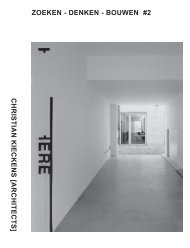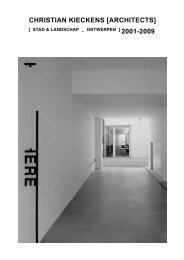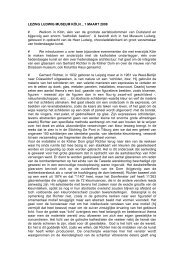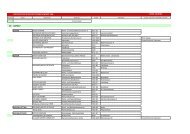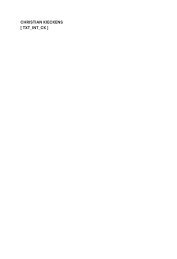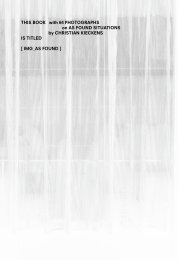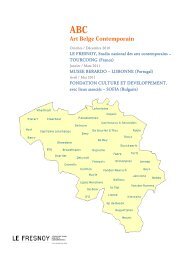download pdf - Christian Kieckens Architects
download pdf - Christian Kieckens Architects
download pdf - Christian Kieckens Architects
You also want an ePaper? Increase the reach of your titles
YUMPU automatically turns print PDFs into web optimized ePapers that Google loves.
the interpretation of the classical structure and notions such as soccle, wall, column,<br />
closed/open, as autonomous elements for a coherent architectural language<br />
1928-1929 Haus Stonborough-Wittgenstein (House Wittgenstein), Kundmanngasse,<br />
Wien (A)<br />
Ludwig Wittgenstein (& Paul Engelmann)<br />
underlying layer of philosophy and mathematics, proportions and enfilade of spaces as<br />
an answer (acceptation and rejection) on history<br />
1993 Lagerhaus Ricola (Ricola Factory), Rue de l'Ill, Mulhouse-Brunnstatt (F)<br />
Jacques Herzog & Pierre de Meuron<br />
the conceptual point of view, the reduction, tectonic of the building and the relation with<br />
techniques and the formal expression, the relationship with artists<br />
1994-1995 Country house Ungers (Summer residence), Kämpensweg, Köln-<br />
Mungersdorf (D)<br />
Oswald Matthias Ungers<br />
architecture as theme, the heritage of the theme of serving and served spaces, the reduction<br />
of emotional expression, simplicity and recognisability<br />
1996-1998 Schulhaus (School), Paspels (CH)<br />
Valerio Olgiati<br />
the research on the ultimate buildability of the material, the contradiction between private<br />
spaces and collectivity<br />
1908-1911 Haus Goldman & Salatsch (Michaelerhaus / LoosHouse), Michaelerplatz 3, Wien<br />
(A)<br />
Adolf Loos<br />
"ornament and crime", the place of the building and that of the square, possibilities for<br />
other functions, the 'Raumplan'<br />
1932-1936 Casa del Fascio, Como (I)<br />
Giuseppe Terragni<br />
all historical references on 'palazzi urbani', milanese inner courtyards, the geometry, the<br />
order of the facades, the proportion between the single 'orator' and the public<br />
1976-1986 Casa dello studente (Student Housing), Chieti, (I)<br />
Giorgio Grassi & Antonio Monestiroli<br />
collectivity of the space, the arche-type, urbanity, the functional division and the clear<br />
composition, the references with classical urban and rural buildings<br />
1984-1987 Mehrfamilienhaus am Luisenplatz, Eosanderstrasse, Berlin (D)<br />
Hans Kollhoff<br />
the input of the history of a town into one single building, references along tectonics, the<br />
placing and ordening with urban landmarks, the coincidence and irritation in the<br />
composition<br />
1985-1988 Bürohaus (Office Building), Hochstrasse, Basel (CH)<br />
Diener & Diener<br />
the conditions of the context as a conceptual starting point and the result in the formal<br />
expression, the role of the structure for possible re-interpretation, banality as a basic<br />
main item<br />
1992-1997 Kunsthaus (Museum for Contemporary Art), Karl Tizian Platz, Bregenz (A)<br />
Peter Zumthor<br />
the conceptual plan reduction and the materiality of the building, the urban division into<br />
two parts and the junction with the environment, connection of techniques and light,<br />
purity of used spaces<br />
Haus/House:<br />
Theoretical analysis of habitation, house, and home around the following questions:<br />
How does the use of ‘haus” to define a wide typology of buildings (gallery, school, factory,<br />
warehouse, house, apartment building, office building, etc.) in Germanic languages affect the<br />
idea of house as “home,” or as private space? In what ways does the existence of such a<br />
typology, by implying that “house” is not just about living or containing, but about working<br />
(and no longer a simple separation of leisure and work), affect the definition of house in the<br />
domestic context? What can each of these uses (as other types of “house”) offer to the<br />
traditional house?



